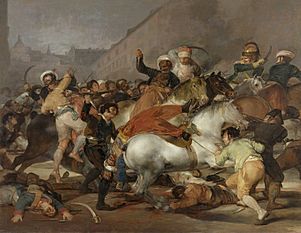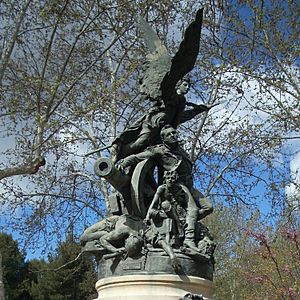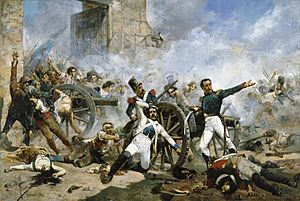Dos de Mayo Uprising facts for kids
Quick facts for kids Dos de Mayo |
|||||||
|---|---|---|---|---|---|---|---|
| Part of the Peninsular War | |||||||
 The Second of May 1808: The Charge of the Mamelukes, by Francisco de Goya |
|||||||
|
|||||||
| Belligerents | |||||||
| Commanders and leaders | |||||||
|
|||||||
| Casualties and losses | |||||||
| 31 killed, wounded or captured 150 dead 31 dead, 114 wounded |
200 killed, wounded or captured 200 dead, 200 wounded, 300 executed |
||||||
The Dos de Mayo (which means "Second of May") was a big uprising in Madrid, Spain, on May 2, 1808. It happened because the city was occupied by French soldiers. Most of the people fighting were ordinary citizens, helped by a few brave Spanish army officers. The French army stopped the rebellion very harshly, and many people were executed. This event was a key moment that led to the long and difficult Peninsular War.
Contents
Why the Uprising Happened
Before the uprising, Napoleon's army had taken control of Madrid on March 23, 1808. The King of Spain, Charles IV, had been forced to give up his throne. This happened during an event called the Tumult of Aranjuez. His son, Ferdinand VII, became the new king.
At the time of the uprising, both kings were in a French city called Bayonne. Napoleon had insisted they go there. The French general, Joachim Murat, tried to move the king's youngest son, Francisco de Paula, and other royal family members to Bayonne. This attempt made the people of Madrid very angry and sparked the rebellion.
Ordinary People's Uprising
The Dos de Mayo was special because it was a spontaneous uprising by ordinary people. It wasn't planned by government leaders or the army. Many Spanish officials wanted to get rid of the French. However, they thought it was too hard to attack Madrid directly.
Two important army officers, Daoíz and Velarde y Santillán, were surprised by the uprising. Velarde, a young artillery captain, was secretly planning a fight in another part of Spain. He thought attacking Madrid was not practical. But when he heard the gunfire, he joined the fight. He died defending the Monteleón artillery barracks.
How the Uprising Began
On May 2, a large crowd gathered outside the Royal Palace in Madrid. They went into the palace grounds. They wanted to stop the French from taking Francisco de Paula away. Marshal Murat, the French general, sent soldiers from the Imperial Guard and artillery to the palace.
The French soldiers fired at the crowd. This made the rebellion spread quickly to other parts of the city.
Street Fights in Madrid
Soon, there was street fighting all over Madrid. The people of Madrid were not well-armed. They fought bravely against the French troops. Murat quickly moved most of his soldiers into the city. There was heavy fighting near the Puerta del Sol and the Puerta de Toledo.
Marshal Murat declared martial law, meaning the military took full control. Slowly, the French army regained control of the city. Hundreds of people died in the fighting. The famous Spanish artist Goya painted a picture called The Charge of the Mamelukes. It shows the street fighting. It shows French soldiers called Mamelukes fighting Madrid residents. These Mamelukes wore turbans and used curved swords. This reminded people of Spain's past with Muslim rule.
There were Spanish soldiers in the city, but they stayed in their barracks. Only the artillery units at the Monteleón barracks disobeyed orders. They joined the uprising. Two officers from these units, Luis Daoíz de Torres and Pedro Velarde y Santillán, are remembered as heroes. They both died when the French attacked their barracks. The rebels were greatly outnumbered.
What Happened After the Uprising

The French punished the rebels very harshly. On the evening of May 2, Murat set up a military court. This court ordered death sentences for anyone caught with any kind of weapon. Murat said that French blood had been spilled and demanded revenge. He stated that all those arrested with weapons would be shot.
All public gatherings were banned. People were ordered to hand over all their weapons. Hundreds of prisoners were executed the next day. Goya captured this terrible scene in his famous painting, The Third of May 1808. The French had been attacked with many different tools, not just weapons. So, craftsmen found with things like scissors, kitchen knives, or sewing needles were also shot. Only a few people who could speak French were able to avoid being executed.
On the same day, May 2, news of the harsh actions reached the nearby town of Móstoles. A man named Juan Pérez Villamil encouraged the town's mayors to sign a declaration of war. This declaration called on all Spaniards to rise up against the French invaders. It was known as the "Edict of the Independence."
The Uprising's Lasting Effects
The Dos de Mayo uprising marked the start of a major rebellion in Spain and Portugal against French rule. This led to the long and bloody Peninsular War.
The French invasion of Portugal had already begun in 1807. But the Dos de Mayo uprising also sparked a rebellion in Portugal. The British army later joined the fight. Their intervention started with the Battle of Roliça, led by Wellington.
The uprising also led to the start of organized Spanish warfare against the French. Napoleon then began his own invasion of Spain.
See also
 In Spanish: Levantamiento del 2 de Mayo para niños
In Spanish: Levantamiento del 2 de Mayo para niños


